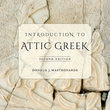 Accentuation Tutorial
Accentuation Tutorial

|
TOPICS Accent and Accent-Marking in Ancient Greek The Last 3 Syllables and the Accents Persistent Accentuation |
In the inflection of nouns and adjectives of the o- and a-declensions, the accent persists on the syllable that is accented in the nominative singular form of a noun or the nominative singular masculine form of an adjective. The changes in position and type of accent that are seen in other forms depend on the length of the ultima and on a few other rules specific to these declensions. (1) for words of the o- and a-declensions with accent persistent on U, the accent is acute (or grave in connected utterance) in the nominative, accusative, and vocative forms, but circumflex in the genitive and dative forms of all numbers. (2) a long accented P followed by a short U must have a circumflex (this is a general rule applying to all Greek forms). (3) for nouns of the a-declension, the genitive plural always has a circumflex accent on U, no matter what the accentuation of the other forms. (The Attic and Koine Greek ending -ῶν is a contraction of the original form -άων.) Examples are shown on the next two screens. |
||||